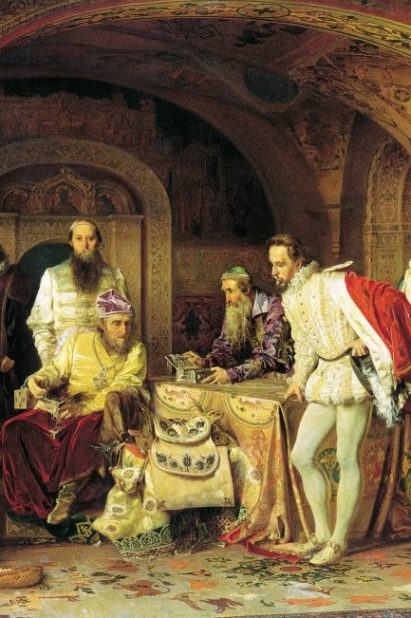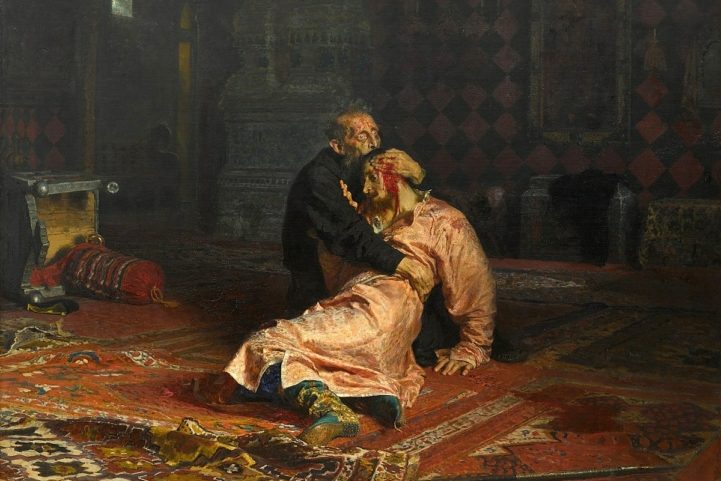Ivan the Terrible or Ivan the Fearful deservedly deserved his title. Besides killing one of his sons with both hands, and beating his pregnant wife until she miscarried, Russia suffered during his reign from the scourge of wars, famines and mass massacres, and the poor and rich of the empire witnessed types of oppression and torture that not even the most close ones were spared. mechanism.
Ivan the Terrible was the first to take the title “Caesar” in the history of Russia, turning it into a centralized empire of power. Against the Kingdom of Sweden, Poland and Lithuania.
Ivan the Terrible and the “divine” leadership according to his belief
When his father, Vasily III, died, Ivan IV was only three years old, yet he was crowned prince of Moscow in 1533, and his mother, Elena Glinskaya, took over the guardianship of him, but she died at the age of eight and many historians believe that she was assassinated by poison .
After that, a group of nobles who called themselves “the Chosen Council” took power on his behalf, but their absolute rule did not last long. Ivan took power himself when he reached the age of 14, and as soon as the year 1547 came, he declared himself the first Caesar in the history Russia.
Ivan chose for himself the title Caesar (derived from Roman) primarily to consolidate the power of his throne and send a message to the world that he is no less powerful than the Byzantine Caesars known throughout history.
The title also had religious connotations, as the Caesar has always been associated in ancient ecclesiastical texts with the king who carries out God’s will on earth.
Being one of the faithful followers of Orthodox Christianity, Evan fought hard for his “divine” right as a ruler who should possess unlimited authority after God according to their beliefs.

Caesar is haunted by doubt and distrust
Ivan the Terrible began his reign as the first tsar in the history of Russia by getting rid of the members of the Chosen Council.
In 1553, the first quarrel occurred between Ivan and one of his noble advisors. Prince Andrei Kurbsky defected from him, siding with the Lithuanians, and he even took command of the Lithuanian forces and destroyed the Russian region of Veliky Luki.
As a result of this incident, Ivan became possessed by doubt and suspicion, and began a frantic war against all the nobles who doubted their loyalty, even those close to him, and committed many massacres against them.
His preferred method of torture was smashing the legs before throwing his victims into the snow or making them crawl and beg for mercy.
In his era, aristocratic women were also subjected to mass rapes and murders, and he did not hesitate to exterminate entire societies when he doubted their loyalty.
Evan recruited for these works people who were not hereditary owners of money and real estate, but gave them authority over large areas of land to do as they pleased without accountability.
They began imposing exorbitant taxes on the Russian peasants and forcing them to pay in one year what they had previously paid in ten, which led to a terrible decline in crop production and an unprecedented decline in the Russian economy.
Why was Ivan IV so cruel?
Some scholars explain the sadistic and brutal actions of Ivan the Terrible as being associated with the religious concepts of the 16th century.
Which included drowning and burning people alive or torturing the victims with boiling or very cold water, in accordance with the torment of hell, given that he is considered the representative of God on earth and has a sacred right and duty to punish his opponents.
Some historians believe that the death of Ivan’s first wife, Anastasia Romanovna, had a significant impact on his personality, and perhaps on his mental health as well. After this incident, he became completely out of control to the extent that he killed his son in the last years of his life.

Occupation of Kazan and Astrakhan
Ivan IV pursued an expansionist policy in his rule, which was aimed at controlling between the Baltic Sea and the Caspian Sea. Therefore, the Tsar fought wars, as a result of which the lands of his empire expanded to become a sprawling empire.
In 1552, Ivan the Terrible besieged Kazan and cut off the water supply from it until it finally fell and the Kazan tribe fell. He committed mass massacres against Muslims because of their religion and tried to convert many of them by force.
While Ivan ordered the demolition of mosques and prevented their re-establishment, he celebrated his victory over Kazan by building several churches with oriental features, the most famous of which was St. Basil’s Cathedral on Red Square in Moscow.
In 1554, he was able to occupy Astrakhan and thus the Volga River became a purely Russian channel that facilitated access to the Caspian Sea, and paved the way for the Russian occupation beyond the Urals. Siberia was settled in 1555, and the Russians occupied the Bashkir land in 1557, during his reign and Ivan’s goal was The main military terrible ruled Poland and Sweden and established relations with Europe as well, but he failed in his wars with the countries of Europe, especially Lithuania and Poland.
Livonian War
Tsar Ivan IV fought bloody wars, in which he expanded the territory of Russia and made it a vast empire.
While he was able to occupy Tatarstan and Siberia, other wars constituted an unjustified drain on the energies of his state, such as his war with the Ottoman Turks, during the reign of Sultan Selim, which ended with a peace treaty concluded in Constantinople after nearly three years of fighting.
In addition to the Livonian War, which devastated Russia, exhausted its people and weakened its resources, this 24-year war began in 1558.
This ultimately unsuccessful war was an attempt by Ivan to gain access to the Baltic Sea and major trade routes.
He clashed for that with the Kingdom of Sweden, Poland, Lithuania and Livonia.
Ivan only gained from this war the doubling of the refugees who fled the war, who in turn multiplied the famines in the country, along with the aggravation of epidemics and great loss of life.
Novgorod massacre
Perhaps the most notable atrocities committed by Ivan in his later years were the Novgorod massacre and the burning of the Tatars in Moscow.
After a plague broke out in Russia in 1570, killing more than 10,000 people in Novgorod and nearly a thousand people a day in Moscow, and famines spread and the useless Livonian War continued, Ivan suspected that the nobles in the wealthy city of Novgorod were planning to defect. .
Caesar decided to anticipate events and raid the city and loot it with the surrounding villages, committing a horrific massacre, the number of victims of which exceeded 60 thousand victims, according to some historians. The massacre lasted for five days and included men, women and children.
The victims, including women and children, were said to have been strapped to sledges and pushed into the freezing waters of the Volkhov River to drown and hail, and many monks were killed and tortured to death.
Evan kills his son
Despite the church’s absolute ban on the issue of polygamy, Ivan exceeded these laws and had seven wives, according to historians.
It is reported that in 1581, Ivan beat his pregnant wife (Yelena Sheremeteva) for wearing indecent clothing, which aborted the fetus.
While his son, called Ivan, also could not stand this sight, the son got into a heated argument with his father, which ended with Ivan the Terrible hitting his son on the head, leaving him with severe wounds that eventually led to his death.
This event is depicted in the famous painting by Ilya Repin, in which Ivan is shown holding the head of his murdered son with grief and regret.

The last chess game
Although Ivan feared the consequences of his massacres, as some historical sources mention, he died a quiet death of a stroke while playing chess on March 28, 1584.
He had withdrawn in his late days to live a monastic life, despite the wars he had waged before over the priestly authority.
After the death of the first Russian tsars, the throne passed to his middle son, Fyodor, who died without offspring, and Russia then descended into what was known as the “time of unrest.”
Sunna Files Free Newsletter - اشترك في جريدتنا المجانية
Stay updated with our latest reports, news, designs, and more by subscribing to our newsletter! Delivered straight to your inbox twice a month, our newsletter keeps you in the loop with the most important updates from our website











